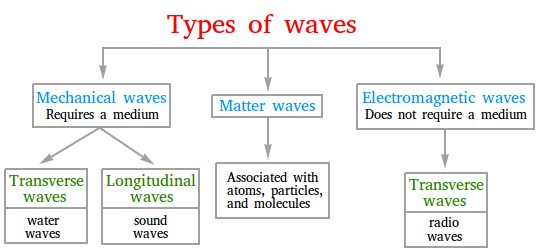Types of waves
The 3 main types of waves are mechanical waves, electromagnetic waves, and matter waves.

Definitions and explanations of the different types of waves
Mechanical waves
A mechanical wave is a wave that can only exist within a material medium such as air, water, or rock. We encounter mechanical waves almost constantly, so we should be familiar with them.
Examples of mechanical waves include to mention a few the following:
Slinky waves
Sound waves
Water waves
Seismic waves
Jump rope waves
Mechanical waves can either be transverse waves or longitudinal waves.
What are transverse waves?
With transverse waves, the vibrations are perpendicular to the direction of motion. In other words, while the particles move up and down, the wave travels to the right or to the left.
What are longitudinal waves?
With longitudinal waves, the vibrations are parallel to the direction in which the wave travels. For instance, while the particles vibrates from left to right, the wave travels to the right.
This website has an animation that shows the difference between transverse and longitudinal waves.
Electromagnetic waves
Unlike mechanical waves, electromagnetic waves do not require a material medium to exist. Instead they travel through a vacuum at the speed of light.
Examples of electromagnetic waves include to mention a few the following:
- Radio waves
- Television waves
- Microwaves
- X rays
- Radar waves
- Light waves from stars
Electromagnetic waves can be transverse waves.
Matter waves
You are much less familiar with this type of wave. It is mostly used in modern technology.
This type of wave is associated with particles, atoms, and molecules.
It got its name from the fact that matter is made of lots of atoms, particles, or molecules.